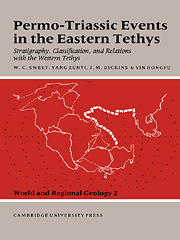 Permo-Triassic Events in the Eastern Tethys
Permo-Triassic Events in the Eastern Tethys Published online by Cambridge University Press: 12 October 2009
Introduction
In China, nonmarine Permian and Triassic strata are distributed mainly in the vast area north of a line formed by the Kunlun, Qinling, and Dabie mountains. They are particularly well developed in the Junggar, Turpan, and Shaanxi-Gansu-Ningxia basins. South of the line, nonmarine Permo-Triassic sediments occur mostly in eastern Yunnan and western Guizhou. In addition, alternating marine and continental Permian and Triassic rocks are also developed in a few areas in both South and North China. In the past decade or so great progress has been made in studies of both the biological and nonbiological features of the nonmarine Permo-Triassic boundary. Existing data reveal distinct changes across the boundary in biologic groups such as vertebrates, bivalves, ostracodes, spores, pollen, and other flora, and in nonbiologic features such as grain size and color of sediments, sedimentary environments and climate. These changes suggest an event between the Permian and Triassic and can be applied to correlation of the nonmarine Permo-Triassic boundary.
Biotic changes
Determination of the Permo-Triassic boundary in nonmarine sequences is made at present mainly on the basis of vertebrates and spore-pollen assemblages, and to a lesser extent, on the basis of ostracodes, bivalves, and other elements of the flora.
Vertebrate fauna
The vertebrate fauna changes markedly from Permian to Triassic. Dicynodonts such as Kunpania scopulusa, Striodon magnus, Jimusaria sinkiangensis, Dicynodon tienshanensis, Jimusaria taoshuyanensis, Turfandon bogdaensis and Kansuodon sp. are represented in Upper Permian strata in the Junggar and Turpan basins of Xinjiang and Gansu provinces, northwest China (Zhao, 1980; Yang et al., 1986). A Pareiasaurus fauna, represented by Tapinocephalidae and Shihtienfenia permica, and Shansisaurus xuecunensis, has been reported from equivalent strata in Shanxi and Shaanxi provinces, North China.
To save this book to your Kindle, first ensure [email protected] is added to your Approved Personal Document E-mail List under your Personal Document Settings on the Manage Your Content and Devices page of your Amazon account. Then enter the ‘name’ part of your Kindle email address below. Find out more about saving to your Kindle.
Note you can select to save to either the @free.kindle.com or @kindle.com variations. ‘@free.kindle.com’ emails are free but can only be saved to your device when it is connected to wi-fi. ‘@kindle.com’ emails can be delivered even when you are not connected to wi-fi, but note that service fees apply.
Find out more about the Kindle Personal Document Service.
To save content items to your account, please confirm that you agree to abide by our usage policies. If this is the first time you use this feature, you will be asked to authorise Cambridge Core to connect with your account. Find out more about saving content to Dropbox.
To save content items to your account, please confirm that you agree to abide by our usage policies. If this is the first time you use this feature, you will be asked to authorise Cambridge Core to connect with your account. Find out more about saving content to Google Drive.